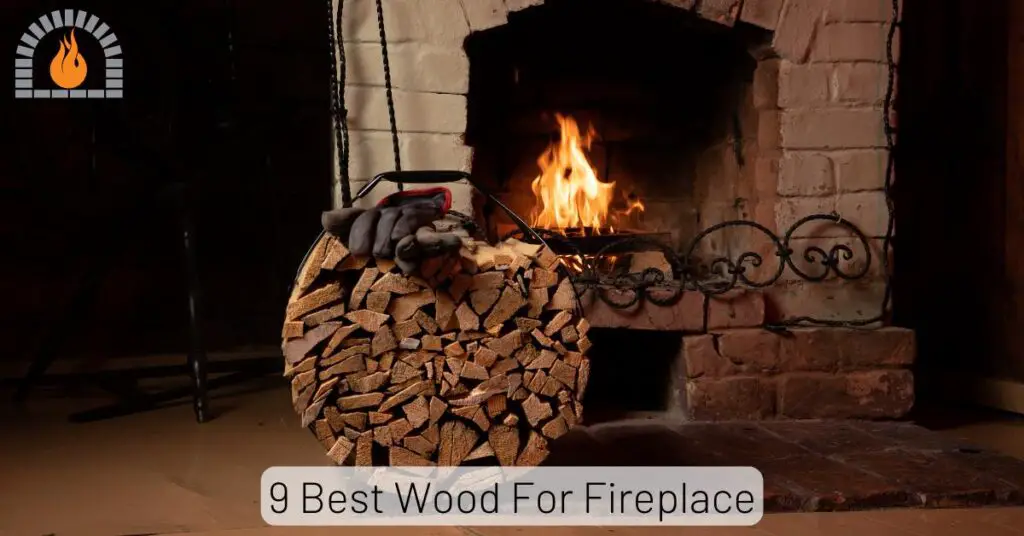Properly storing firewood outside during winter is essential for maintaining dry, well-seasoned wood that burns efficiently and safely. To store firewood outside in winter effectively, you need to choose a sunny, elevated location, stack wood off the ground with adequate airflow, cover only the top portion to protect from precipitation while allowing sides to breathe, and maintain proper distance from structures to prevent pest infestations.
This comprehensive guide will walk you through everything you need to know about keeping your firewood dry and ready to use throughout the cold season, ensuring you have a reliable heat source when temperatures drop.
Key Takeaways
- Proper firewood storage in winter requires a sunny, elevated location with good drainage and protection from prevailing winds while maintaining adequate airflow.
- Always store firewood at least 30 feet away from structures to prevent pest transfer and reduce fire hazards.
- Elevate wood off the ground using pallets, racks, or other methods to prevent ground moisture absorption.
- Cover only the top portion of your firewood stack, leaving sides exposed for proper airflow and continued seasoning.
- Stack wood in stable rows or patterns with small gaps between pieces to promote air circulation and drying.
- Regular maintenance including snow removal, cover adjustment, and systematic usage ensures your firewood remains dry and ready to use throughout winter.
- Monitor moisture content and remove any moldy or rotten pieces promptly to maintain the quality of your firewood supply.
- Consider your specific climate conditions and the amount of snowfall in your area when choosing the best storage method for your needs.
Why Proper Firewood Storage Matters in Winter
When winter arrives with its biting winds and heavy snowfall, having a well-organized and properly maintained firewood supply becomes crucial for anyone relying on wood heat. Improperly stored firewood not only becomes difficult to use but can also create safety hazards and reduce heating efficiency.
According to the U.S. Forest Service, properly seasoned firewood with moisture content below 20% produces up to 25% more heat than wet or improperly stored wood. This efficiency translates directly to cost savings and less time spent gathering and handling wood throughout the winter months.
Beyond efficiency, proper storage prevents mold growth, reduces pest infestations, and minimizes the risk of fire hazards associated with storing wood too close to your home. As University of Vermont Extension experts note, well-stored firewood also produces less creosote buildup in chimneys, significantly reducing the risk of chimney fires.
How to Store Firewood Outside in Winter
The success of your firewood storage begins with selecting an optimal location. Consider these factors when deciding where to place your winter wood supply:
Sunlight Exposure
Position your firewood where it will receive maximum sunlight exposure. South-facing locations typically receive the most sun during winter months, helping to naturally dry your wood and melt snow accumulation.
Elevation and Drainage
Choose a spot with natural elevation or create a raised platform to prevent water from pooling around your woodpile. As Oregon State University Extension recommends, proper drainage is essential to prevent ground moisture from wicking up into your firewood stack.
Accessibility and Convenience
Balance convenience with safety. While you want your firewood easily accessible during storms and cold weather, it shouldn’t be stored directly against your house. The National Fire Protection Association recommends keeping firewood stacks at least 30 feet away from structures to prevent pest transfer and reduce fire risk.
Wind Protection
Consider natural windbreaks or create artificial ones to protect your woodpile from prevailing winds. However, ensure that protection doesn’t compromise airflow around the wood, which is essential for proper seasoning and drying.
Table: Ideal Firewood Storage Location Characteristics
| Characteristic | Ideal Condition | Why It Matters |
|---|---|---|
| Sunlight | 6+ hours daily | Promotes drying and prevents snow accumulation |
| Distance from home | 30+ feet | Reduces pest transfer to home and fire risk |
| Ground elevation | Slightly elevated | Prevents water pooling and ground moisture absorption |
| Air circulation | Open sides | Allows moisture to escape and wood to season properly |
| Accessibility | Covered pathway | Ensures safe access during winter weather conditions |
Preparing Your Firewood for Winter Storage
Before stacking your firewood for winter storage, proper preparation is essential to ensure optimal seasoning and protection from the elements.
Seasoning Time
Wood Heat Organization experts recommend seasoning firewood for at least 6-12 months before use. For winter storage, this means preparing your wood in spring or early summer to ensure it’s properly dried by the time cold weather arrives.
Cutting and Splitting
Split wood to consistent sizes, typically 6-8 inches in diameter, which allows for faster seasoning and more efficient burning. According to University of Idaho Extension, smaller pieces dry more quickly and are easier to stack securely.
Initial Drying Period
Allow your split wood to air dry in an uncovered, sunny location for several weeks before winter stacking. This initial drying period reduces moisture content significantly before you cover the wood for winter protection.
Sorting by Wood Type
Different wood species have varying drying times and burning characteristics. Hardwoods like oak and maple require longer seasoning but produce more heat, while softwoods like pine dry faster but burn more quickly. Consider sorting and stacking different wood types separately for easier access based on your heating needs.
Best Methods for Storing Firewood Outside in Winter
The Wood Pile Method
The traditional wood pile remains one of the most effective and economical ways to store firewood outside in winter. When creating a wood pile:
- Start with a foundation of pallets or 2×4 runners to elevate wood off the ground
- Stack wood in alternating directions for stability
- Create a peaked top to shed precipitation
- Leave gaps between logs for airflow
- Cover only the top third of the pile with a tarp or specialized firewood cover
The University of Maine Cooperative Extension recommends this method for its simplicity and effectiveness when properly executed.
Using a Firewood Rack
Firewood racks offer a more organized and often more durable solution for winter wood storage:
- Choose a sturdy, rust-resistant metal rack or build one using pressure-treated lumber
- Position the rack in your pre-selected optimal location
- Stack wood neatly within the rack, leaving airspace between pieces
- Consider a rack with a built-in cover or add a separate cover system
Racks keep wood organized and off the ground while making it easier to access specific pieces during winter. Popular Mechanics offers detailed plans for building both simple and elaborate firewood rack systems.
Building a Firewood Shed
For those with larger wood supplies or living in areas with heavy snowfall, a dedicated firewood shed provides the ultimate protection:
- Design a shed with a raised floor and open or partially open sides for ventilation
- Include a roof with sufficient overhang to protect stacked wood
- Consider adding a covered area for kindling and fire-starting materials
- Orient the shed to take advantage of sunlight and prevailing winds
The USDA Natural Resources Conservation Service provides technical guidance for small structures like woodsheds, including proper siting and construction techniques.
Covering Techniques for Winter Protection
Proper covering is essential regardless of your storage method:
- Use specialized firewood covers or heavy-duty tarps rated for winter weather
- Cover only the top portion of your stack, leaving sides exposed for airflow
- Secure covers tightly to prevent wind damage but allow some ventilation
- Remove covers during dry, sunny periods to allow additional drying
Ohio State University Extension experts emphasize that covering the entire pile traps moisture and can lead to mold growth and decay.
Protecting Firewood from Moisture and Snow
Moisture is the primary enemy of well-seasoned firewood. Implement these strategies to keep your winter wood supply dry:
Ground Moisture Barriers
Even elevated wood can absorb moisture from the ground. Create additional protection by:
- Laying a layer of gravel beneath your storage area
- Using plastic sheeting under pallets or runners
- Installing a vapor barrier between the ground and your foundation
Snow Management
Heavy snowfall can bury and saturate firewood piles. Prepare for winter storms by:
- Installing temporary snow fences or windbreaks
- Creating a snow removal plan for your wood storage area
- Using steeply angled covers that shed snow effectively
- Keeping a shovel or snow blower accessible for clearing access paths
Moisture Monitoring
Regularly check your firewood’s moisture content throughout winter:
- Invest in a moisture meter for accurate readings
- Target moisture content below 20% for optimal burning
- Rotate wood from the bottom and outer edges to the center for continued drying
- Identify and remove any moldy or rotten pieces promptly
The Wood Energy Technology Transfer program provides detailed guidance on moisture testing and optimal moisture levels for different wood species.
Keeping Pests Away from Your Winter Firewood Supply
Firewood piles can attract various pests seeking shelter and food during winter. Implement these strategies to minimize pest problems:
Elevated Storage
As mentioned earlier, keeping wood off the ground is one of the most effective pest deterrents. It makes it more difficult for insects and rodents to access your wood supply.
Distance from Structures
Maintain adequate distance between your firewood and any buildings, as recommended by the Environmental Protection Agency. This prevents pests from easily migrating from your woodpile to your home.
Regular Inspection
Periodically check your woodpile for signs of infestation:
- Look for sawdust or frass (insect waste) indicating wood-boring insects
- Check for rodent nests or tunnels within the stack
- Remove any obviously infested pieces immediately
- Consider natural deterrents like cedar blocks or peppermint oil around the perimeter
First-In, First-Out System
Organize your woodpile to use older wood first, reducing the time pests have to establish themselves in your supply. This practice also ensures you’re burning the most seasoned wood first.
How to Stack Firewood for Optimal Seasoning and Airflow
Proper stacking technique is crucial for maintaining dry, well-seasoned firewood throughout winter:
Row Stacking
The most common method involves stacking wood in parallel rows:
- Place larger pieces at the bottom for stability
- Stack pieces tightly enough to prevent falling but with small gaps for airflow
- Create rows no higher than 4 feet for stability and ease of access
- Leave at least a foot between rows for ventilation and access
End Pillars
For longer rows, create stable end pillars using one of these methods:
- The Crisscross Method: Alternate the direction of pieces at the ends to create self-supporting pillars
- The Post Method: Drive sturdy posts into the ground at each end to support the stack
- The Tower Method: Build interlocking towers at each end using larger pieces
Circular Stacking
For an efficient use of space and excellent stability:
- Create a circular base approximately 6-8 feet in diameter
- Stack wood in a spiral pattern, leaning slightly inward
- Continue upward, tapering the circle slightly as you go
- Finish with a protective cover on top
The Forestry Commission recommends this method for its stability and efficient use of space, especially in smaller yards.
Holzhausen Method
This traditional European stacking technique creates a self-supporting, highly efficient pile:
- Create a circular base approximately 10-12 feet in diameter
- Stack wood vertically around the perimeter, leaning inward
- Fill the center with randomly placed wood
- Continue building upward, creating a dome shape
- Finish with a protective cover or thatched top
This method provides excellent protection from precipitation while maintaining good airflow, making it ideal for winter storage in areas with heavy snowfall.
Maintaining Your Firewood Storage Throughout Winter
Once your firewood is properly stored for winter, regular maintenance ensures it remains dry and ready to use:
Snow and Ice Removal
After winter storms:
- Carefully remove snow from the top of your pile or covers
- Clear access paths to your wood supply
- Check for ice accumulation that could damage covers or restrict airflow
- Remove any fallen branches or debris that might trap moisture
Cover Adjustment
As winter conditions change, adjust your covering strategy:
- Remove covers during dry, sunny periods to allow additional drying
- Ensure covers are secure before approaching storms
- Replace damaged covers immediately
- Consider adding additional protection during particularly wet or snowy periods
Rotation and Usage
Implement a systematic approach to using your winter wood supply:
- Always take wood from the oldest, most seasoned sections first
- Re-stack any disorganized areas to maintain stability and airflow
- Move wood from outer, more exposed areas to more protected positions
- Keep detailed records of your wood usage to plan for future seasons
End-of-Season Transition
As winter ends, prepare for the storage needs of the upcoming season:
- Use remaining winter wood first to make space for new supplies
- Clean and repair storage structures and covers
- Evaluate the effectiveness of your storage methods and make improvements
- Begin preparing and stacking new wood for the next winter season
FAQs
How long does firewood need to season before winter use?
Most firewood requires 6-12 months of proper seasoning before it’s ready for winter use. Hardwoods like oak and maple typically need closer to 12 months, while softwoods like pine may be ready in 6 months. The key indicator is moisture content—properly seasoned wood should have a moisture content below 20% for optimal burning efficiency.
Should I cover my entire firewood pile in winter?
No, you should only cover the top third of your firewood pile. Covering the entire pile traps moisture and prevents proper airflow, leading to mold growth and continued high moisture content. Leave the sides exposed to allow air circulation and additional drying during sunny periods.
How far from my house should I store firewood?
Firewood should be stored at least 30 feet away from your home or any other structures. This distance helps prevent pests from easily migrating from the woodpile to your home and reduces fire risk. While it may seem inconvenient during winter weather, the safety benefits outweigh the minor inconvenience.
Can I store firewood directly on the ground?
No, firewood should never be stored directly on the ground, especially during winter. Ground moisture will wick up into the wood, increasing moisture content and promoting decay. Always elevate your firewood using pallets, a rack, or other methods that create a barrier between the wood and the ground.
How do I prevent pests from infesting my winter firewood supply?
To prevent pest infestations, elevate your wood off the ground, maintain proper distance from structures, inspect regularly for signs of pests, and implement a first-in, first-out usage system. Natural deterrents like cedar blocks or peppermint oil around the perimeter can also help discourage pests from taking up residence in your woodpile.
Affiliate Disclosure: Fireplaceadviser.com is a participant in the Amazon Services LLC Associates Program. We may earn a commission when you click on certain links on this site and purchase.

Hello!! I am Jamal Khan. I often fix my home electric heaters and gas stove problems and research the common issues in the heating units to improve my knowledge and expertise. The aim of establishing fireplaceadviser.com is to share my expertise and knowledge with my audience.


















